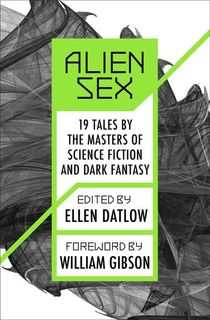James Tiptree Jr. left an enduring mark on modern speculative fiction — but she’s perhaps more mysterious and enigmatic today than ever before.
Tiptree was one of the pen names used by female sci-fi author Alice Bradley Sheldon (née Alice Hastings Bradley). The daughter of prolific fiction writer Mary Hastings Bradley, Sheldon may have been born with the gift of words, but her path to literary success wasn’t clear-cut.
Although Sheldon is best known for her sci-fi writing, she had an eclectic and accomplished career. At various times in her life, Sheldon was a research psychologist, painter, art critic, imagery intelligence operative, CIA operative, and more. In many of these fields, she was one of the few women in an industry dominated by men.
In her mid-20s, Sheldon became a graphic artist, painter, and art critic for the Chicago Sun. Following her divorce from her first husband, she joined the Women's Army Auxiliary Corps, and entered the United States Army Air Forces in 1942, working in a photo-intelligence group.
Sheldon married her second husband, Huntington D. Sheldon (whom Sheldon referred to as ‘Ting’), near the close of the war. They opened a small business together after she was discharged from the military in 1946.
RELATED: 20 Impactful Female Science Fiction and Fantasy Authors
It was at this time that Sheldon published her very first short story, “The Lucky Ones,” in The New Yorker under her own name. But rather than focus on writing, she took another career detour, as the Sheldons were recruited by the CIA in 1952.
Resigning as an intelligence officer three years later, Alice Sheldon returned to college and eventually received her doctorate in experimental psychology.
In 1967, Sheldon began using her Tiptree pseudonym, becoming known as “Tip” to her correspondents. She made this decision in order to maintain her academic reputation, as well as to prevent the scrutiny concomitant with being a woman in a stereotypically male profession.
Sheldon’s pseudonym — inspired by a brand of marmalade — coincided with her determination to write the kind of science fiction stories she was personally interested in.
RELATED: 10 Female SF/F Authors and the Stories Behind Their Pen Names
As Tiptree rose to success in the science fiction world of the late-60s and beyond, speculation that she might be a woman was met with incredulity, due in part to the mysterious author’s reputation as a rakish adventurer.
Through a post office box in Virginia, Tiptree corresponded with many of her fellow sci-fi authors. Prominent writer Robert Silverberg, who wrote to Tiptree frequently, called debate over the author’s gender “absurd,” and said Tiptree’s writing was even “superior in masculinity” to that of Ernest Hemingway.
Nonetheless, it was a woman cranking out the wealth of short stories that carved the forward path of science fiction. Her works ranged from technologically-based hard science fiction, to softer science fiction with a psychological focus.
Filled with both empathy and darkness, Tiptree’s writing is populated by characters who are alienated and alarming. Her work frequently deals with themes of death, the tension between free will and determinism, and sexual politics.
RELATED: Alien Sex: James Tiptree Jr.'s Cautionary Tale of Otherworldly Lust
In 1973, Tiptree—then 58 years old—published her first collection of science fiction short stories, Ten Thousand Light-Years from Home. The collection included notable early works such as “I'm Too Big but I Love to Play” (1970), “The Man Who Walked Home” (1972), and “And I Awoke and Found Me Here on the Cold Hill's Side” (1972).
The latter story, named after a line from a Keats poem, is set in the far future. It follows a space station engineer determined to warn a young journalist against interspecies sexual obsession.
The following year, Tiptree published The Girl Who Was Plugged In. This gripping story—which won the 1974 Hugo Award for Best Novella—takes place in a dystopian capitalist regime. Although advertising is illegal, corporations manipulate consumers through constructed product placement celebrities.
The story follows 17-year-old social pariah P. Burke, who is scouted to operate a mindless corporate creation named Delphi. As Delphi influences the public, P. Burke falls in love with her new surrogate lifestyle. But trouble follows when she uses Delphi to begin a love affair with the rebellious Paul Isham.
RELATED: 20 Short Story Collections and Anthologies Every Sci-Fi & Fantasy Fan Should Read
In 1976, Sheldon’s mother died. Mary Bradley’s obituary mentioned the late woman’s surviving daughter, and some readers noticed biographical similarities between Bradley’s life and the childhood described by Tiptree, who had confided to epistolary acquaintances that “his” mother had recently died.
Tiptree, the famously ‘masculine’ and private writer, was unmasked as 61-year-old Alice Bradley Sheldon.
Of this period in her life, Sheldon would later write, "My secret world had been invaded and the attractive figure of Tiptree — he did strike several people as attractive —was revealed as nothing but an old lady in Virginia."
The widespread public came to know the truth about the identity behind the Tiptree pen name, but many of Tiptree’s pen pals continued to correspond with Sheldon. One of these was Joanna Russ, a fellow sci-fi author and a lesbian feminist, who wrote to Sheldon after the reveal, “I was in love with you when you were ‘James Tiptree, Jr’ and have been able to transfer that infatuation to Allie Sheldon, who is, after all, the same person.”
Despite the revelation about her identity, Sheldon/Tiptree went on to have an incredible literary year with the publication of her novella Houston, Houston, Do You Read?
RELATED: 10 Stunning Anthologies Edited by Award-Winner Ellen Datlow
This title won the Hugo Award, the Nebula Award, and the Jupiter Award. Published in numerous collections in the years that followed, the story is about three male astronauts on a circumsolar mission in the near future. After their craft is damaged by a large solar flare, the trio is left drifting. However, their radio soon picks up peculiar communications from an unknown source.
RELATED: Brilliant Reads for Fans of Ray Bradbury Books
Tiptree’s first full-length novel, Up the Walls of the World, was published in 1978. As the planet Tyree stands in the path of danger from a star-eating leviathan known as the Destroyer, Earth struggles under the weight of psionic powers cultivated in a secret military experiment.
The only other full-length novel in Tiptree’s career, Brightness falls from the Air, was published seven years later in 1985.
In this tale, 16 humans gather on the isolated planet of Damien to watch a dying star. But the true motives of these space tourists are soon revealed, as the secrets of the star’s destruction and Damien’s isolation also come to light. Horror, justice, judgement, and a peculiar, unforgiving love await them.
RELATED: Explore Exciting Galaxies With These 15 Books for Fans of Mass Effect
In many ways, Sheldon’s death was just as shocking as her life. On May 19th, 1987, Sheldon killed her husband Ting, who was 84 at the time. Sheldon then called her lawyer, before dying by suicide at the age of 71.

Alice and Huntington Sheldon, January 1946.
Photo Credit: Wikimedia CommonsAt the time, Fairfax police called the deaths a “murder suicide.” Others referred to it as a suicide pact.
Attorney Robert F. Horan Jr. said at the time, "Evidently there was some sort of pact between them . . . . It appears that her husband's health was increasingly becoming more difficult for him."
Ting was blind when he died, and Sheldon had been depressed for some time, and had spoken freely to friends about her suicidal ideation. In fact, she had archived the missive that was to be her suicide note eight years before her death. As a friend told The Washington Post in the days following the Sheldons’ deaths, the couple had been “finding life very fragile.”
In 1991, science fiction authors Karen Joy Fowler and Pat Murphy created the James Tiptree Jr. Award, to celebrate SFF works which expand the understanding of gender. The honor’s name was changed to the Otherwise Award in 2019, as members of the SFF community questioned how ableism and the power dynamics between a caregiver and disabled spouse may have played a role in the Sheldons’ deaths.
The literary council wrote of their decision, “We value the disabled writers and readers and artists and fans who support this award. Many of them – many of you – have told us that the Award’s current name holds negative, painful, exclusionary associations. So we’re changing it.”
The literary council’s message reflects the pain and confusion that remains over the deaths of the Sheldons, as well as how conversations about ableism, mental health, and suicide have evolved over the past three decades.
The confusion and controversy surrounding Tiptree/Sheldon’s death is representative of the ambiguity that followed her in life. This ambiguity persisted even after her true identity was revealed, and despite the extensive records and correspondence she carefully archived throughout her career.
Regardless of the wealth of documentation she left behind, the author’s life and death remain as shadowy and nuanced as one of her characters. Even after the world knew who James Tiptree Jr. was, we never really knew her.
[via NPR; JStor; In the Library With the Lead Pipe]
This post is sponsored by Open Road Media. Thank you for supporting our partners, who make it possible for The Portalist to celebrate the sci-fi and fantasy stories you love.





